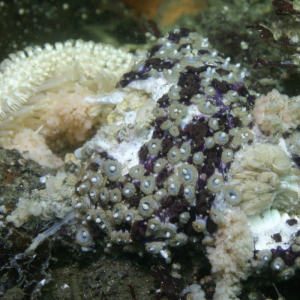Starfish Along West Coast Are Dying, ‘Star Wasting Disease’ Turns Fish Into ‘Goo’ [PHOTO]

Starfish along the West Coast are dying, and marine scientists are struggling to figure out why.
The starfish are stricken with “sea star-wasting disease” that has killed up to 95 percent of the star populations from Alaska to Orange County, the Santa Rosa Press Democrat reports.
"Their flesh deteriorates and there’s nothing to hold them together," Donna Gibbs, diver and taxonomist at the Vancouver Aquarium, told NBC News. "That’s as technical as it gets right now."
The disease, causes lesions on starfish skin that eventually decay, causing them to lose their arms until they disintegrate and become “goo.” Divers began to notice the starfish deaths off Seattle’s Puget Sound in September. Starfish in an aquarium at the Gulf of the Farallones National Marine Sanctuary in San Francisco also fell sick.
In 1983-84, the disease hit Southern California, but it wasn’t as widespread as it is now, Pete Raimondi, chairman of the Department of Ecology and Evolutionary Biology at University of California, Santa Cruz's Long Marine Lab, said.
“We've never seen it at this scale up and down the coast,” Raimondi said.
A team of scientists along with researchers from University of California, Santa Cruz plan on taking samples along the West Coast to qualify the outbreak of the disease over the next three to five months. While the cause remains unknown, the disease typically affects one species of starfish, Pisaster ochraceus, and occurs in warmer waters.
Gary Wessel, a professor at Brown University who's investigating the disease, told NBC News that the disease could be caused by a bacterium or virus rather than a chemical or an environmental factor. While the disease can be contagious between animals, it’s unlikely it would affect humans.
Marine scientists agree that identifying the cause of the devastating disease is hard work.
“When these plagues have occurred in the past, identifying an unknown microorganism -- to say, ‘This is what did it’ -- this is hard work. It’s difficult science,” University of Washington marine ecologist Robert Paine told KUOW Puget Sound Public Radio. “We know there are a gazillion kinds of bacteria and viruses in the ocean.”
Joe Gaydos, a veterinarian from the SeaDoc Society, a wildlife protection program at the University of California, Davis, adds that the disease may be a sign of a larger problem.
“Every population has sick animals,” Gaydos said. “Are we just seeing sick animals because we’re looking for it, or is it an early sign of a large epidemic that may come through and wipe out a lot of animals?”
© Copyright IBTimes 2025. All rights reserved.




















